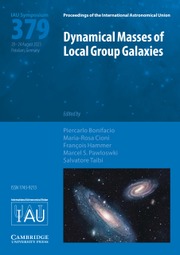No CrossRef data available.
Article contents
The study of the Galactic mass distribution from Gaia DR3 RR Lyrae
Published online by Cambridge University Press: 30 October 2025
Abstract
Based on RR Lyrae with accurate proper motions and classification in Gaia DR3, we determine the Milky Way mass distribution from fitting dynamical models to the gravitational force field and the Galactic rotation curve. Applying Gaussian Mixture Model to the intrinsic velocity distribution, we present the result of a multi-component kinematic model of RR Lyrae in the inner regions 5 ≲ r ≲ 20 kpc. Considering the early accretion history of the MW and thus the stellar halo may not be in equilibrium, we separate the halo population into an isotropic stellar halo and the radially-anisotropic population relevant to a merge event. With a Bayesian approach, we fit the potential model parameters, including the density flattening of the dark matter (DM) halo. Our best-fitting dynamical model suggests a nearly spherical spheroid shape of  , a DM halo mass of
, a DM halo mass of  , total MW mass of
, total MW mass of  .
.
Information
- Type
- Contributed Paper
- Information
- Proceedings of the International Astronomical Union , Volume 19 , Symposium S379: Dynamical Masses of Local Group Galaxies , December 2023 , pp. 72 - 78
- Copyright
- © The Author(s), 2025. Published by Cambridge University Press on behalf of International Astronomical Union


